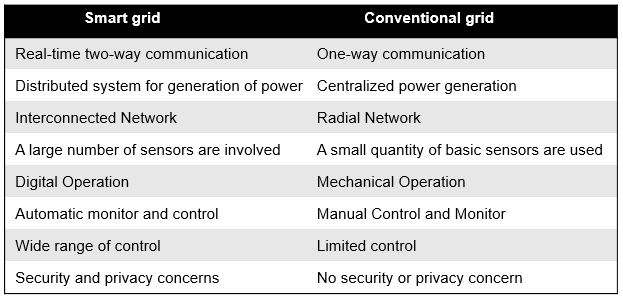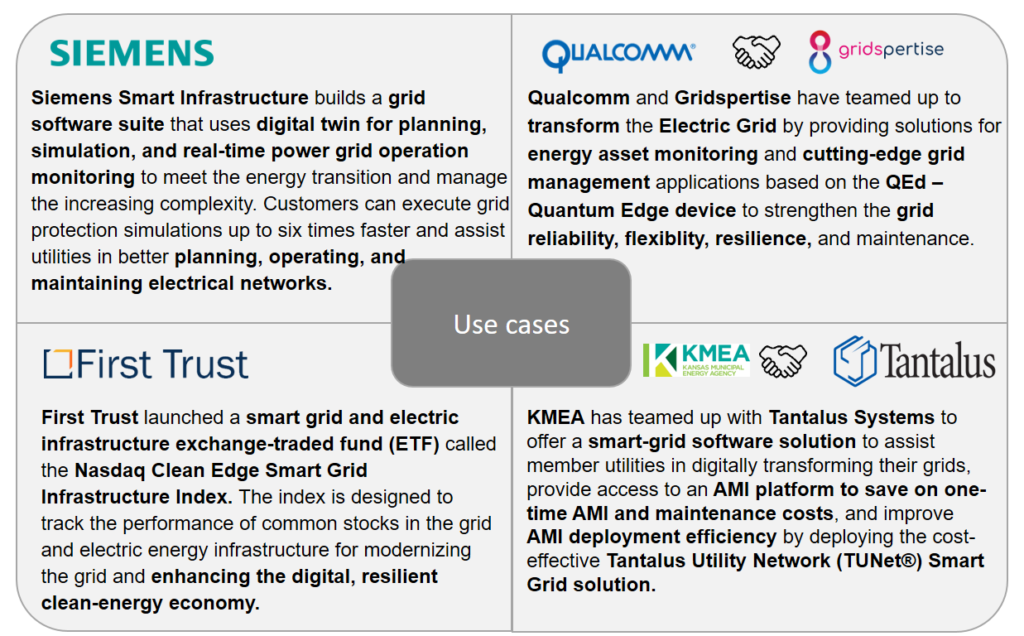What are Smart Grids ?
A smart grid is a digitized, intelligent energy network that can efficiently perform energy transfer between source and consumer. It combines information, telecommunications, and power technologies to provide a two-way communication channel between the service provider and customers, allowing electricity and data to be exchanged. The architecture of a smart grid system consists of various components like energy storage, smart meter, smart substation, distributed generation, phasor measure units, integrated communications, etc. Recent developments in this system include grid tools for smart charging of electric vehicles, electricity theft detection in power grids with convolution neural network (CNN) and Random Forests (RF), etc.Smart Grid Systems
A grid is a network of power cables that distributes electricity to consumers. As the adoption of automation increases, organizations require smart grid technology to manage the power distribution network and its components. The image below summarizes a few differences between conventional and smart grids:

A smart grid is an intelligent network with an automated control and monitoring system that integrates the actions of all stakeholders, including generators, consumers, and those who do both, to provide efficient distribution of electricity and a grid that is sustainable, economically viable, fault-free, and secure from cyber-attacks. Some benefits of incorporating a smart grid into an electrical power distribution system are:
- Easier integration and operation of generators of various sizes and technologies easier.
- It enables customers to participate in the system’s optimization.
- Users can make informed decisions regarding
- Improves system reliability, quality, and supply security.
- Improves existing communication systems and boosts network flexibility by integrating additional intelligence (e.g., temperature control of transformers, real-time thermal monitoring of cables) into network equipment.
- Helpful in reducing the carbon footprint of an electricity distribution network and end-users.
Smart Grid: Architecture
A smart grid system has a highly distributed and hierarchical network architecture. It utilizes intelligent sensing devices to collect information regarding each component of the grid to make an informed decision regarding its operation. The main components of a smart grid include:

- Energy Storage: It is an important part of smart grids. Also, suitable scaling and optimized operation of energy storage devices can lead to effective peak power demand management, increased renewable energy penetration, improved power quality, etc. Typical energy storage systems for smart grids include:
- Electrical energy storage, i.e., electrostatic energy storage, including capacitors, super-capacitors, and magnetic/current energy storage
- Flywheels, compressed air, and hydro-pump energy storage are examples of mechanical energy storage
- Electrochemical conventional batteries, fuel cells, solar fuels, metal-air batteries, and thermochemical reversible processes are examples of chemical energy storage
- Thermal (sensible, latent, and thermochemical) energy storage
- Smart meter: It uses a two-way secure communication network to automatically transmit exact energy usage to the service provider. Additionally, a smart meter with a built-in display screen shows the real-time energy consumption and cost.
- Smart substation: Smart substations support advanced functions such as real-time automatic control of power grids, intelligent regulation, online analysis, and decisions to interact with adjacent substations and power dispatching. In addition, smart substations are responsible for information collection, measurement, control, protection, computation, and monitoring.
- Distributed generation: Distributed generation refers to using small-scale energy-generating techniques at the consumer level along with traditional energy-generation techniques. It can lower prices, improve dependability, reduce emissions, and extend generation options. Energy production takes place close to demand, which reduces transmission line development costs and transmission losses, resulting in increased efficiency.
- Phasor measurement units: Phasor measurement units (PMUs) or synchro phasors, are devices that measure voltages and currents at predetermined places in the utility grid and synchronize with the global positioning system (GPS) radio clock. This technique offers a revolutionary method of managing power flow through the utility grid while also improving security and transmission congestion management in overload situations.
- Sensing and measurement: Advanced sensing and measurement technologies collect and manipulate data to improve the management of the power system. They analyze and monitor equipment health, prevent energy theft, and provide strategy support. They are also used to generate energy bill estimates and analyze grid stability, among other applications.
- Smart appliance: Smart appliances take advantage of cutting-edge computer and communication technology to complete jobs quickly, cheaply, and effectively. Refrigerators, washing machines, toasters, dishwashers, and electric vehicles all tap into smart-grid generation sources. After implementing smart-grid technology, users indicate when and how much electricity they require, thereby minimizing peak demand issues.
- Security: The smart grid system has key security objectives. One objective is to proactively identify anomalies. This helps decrease the attack surface of the smart grid. Another goal is to avoid unintended consequences. The security coverage extends to critical aspects of the smart grid. These aspects include managing user data confidentiality, addressing basic grid faults, and mitigating cyber-attacks.
- Reliability: A smart grid identifies any fault and allows the system to self-heal. As grids grow in size and complexity, it will become more difficult to assess their reliability. Smart Grids are well-suited to address these concerns due to their ability to monitor and retain all data as well as estimate service reliability.
Smart Grids Technologies: Recent Developments
- Development in smart charging of electric vehicles can assist in the development of a smart grid. A few of those innovative concepts are summarized below:
- Distribution system operators (DSOs): DSOs have a communication and control system to manage the charging process and handle charging according to grid restrictions and client needs.
- Distributed energy resources (DER): DER is adjusted to match the supply from renewable energy generation. Moreover, enabling local DER optimization helps DSOs to deal with grid congestion, thereby opening up the possibility of energy reversal.
- Vehicle to grid (V2G) technology: V2G (Vehicle-to-Grid) technology enables smart EV charging by utilizing the vehicle as a temporary storage device. Also, it supplies power to the grid during peak demand and charges the vehicle when overall demand is lowered.
- Electricity theft detection in power grids using CNN and RF:
- A CNN-RF model can be used to detect electricity theft. The CNN acts as an automatic feature extractor while looking at smart meter data, and the RF acts as an output classifier.
- In the field of electricity theft detection, the RF and CNN classifiers have gained popularity and proven to be successful
Smart Grid Use Cases
Extensive investments in the development of smart grids are anticipated in the Middle East and North Africa regions. They create renewable energy and enhance the efficiency of the electrical sector. Additionally, key players in the market include Honeywell International Inc., Hitachi Energy Ltd., Siemens AG, Landis+Gyr, General Electric Company, and many more.
The following are a few of the use cases implemented by different companies:

Conclusion
The concept of the smart grid is constantly growing to efficiently meet energy consumption needs. It also minimizes carbon emissions by incorporating renewable energy sources. Moreover, Improving the reliability, efficiency, and quality of power distribution has the potential to transform the traditional grid and consumer behavior in terms of energy usage.
Although smart meters are useful for operating smart grids in an energy-efficient and profitable manner. Several concerns exist regarding the data collected by smart meters in real time. Obtaining statistics on hourly electricity usage may contain unnecessary information at times. Furthermore, this data collection occasionally infringes on the privacy of users. Also, to improve the privacy of the end-user, there is a need to increase the incorporation of AI-based algorithms and data obfuscation techniques in a more secure smart grid.